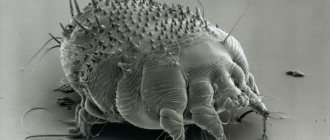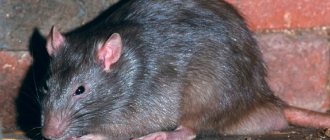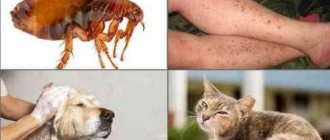What is rat poison
The main component of rat poison is 1st or 2nd generation rodenticides, which are used to exterminate rodents (mice and rats) both in everyday life and in industrial and agricultural enterprises.
A dog can get poisoned while walking
Most of them are anticoagulants, which means that when they enter the blood they interfere with the synthesis of vitamin K. This leads to the fact that the blood can no longer clot, resulting in internal bleeding, which leads to death. Moreover, 1st generation rodenticides such as triphenacin and ethylphenacin have the ability to gradually accumulate in the animal’s body. They are excreted within 14-16 hours, provided that the dose of poison was low. Warfarin has a more persistent effect and therefore poses a greater danger to the pet.
Rat poison is a poisonous substance, any kind of it is dangerous for dogs
To exterminate warfarin-resistant rodents, a number of highly toxic drugs have been developed, such as bromadiolone, dicumarol, etc., which can remain in the body for up to 4-6 days, producing a pronounced toxic effect all this time. Such drugs belong to the 2nd generation rodenticides.
Another class of rat poisons, which includes naphthylthiocarbamide, can be considered the most effective in the fight against rodents. A toxic substance such as zinc phosphide is used if other means do not give the desired result. The drugs are used under strict control and in extremely low doses.
Important! If zinc phosphide enters an animal's body, it can lead to pulmonary edema.
Even a tiny amount of this rat poison is a lethal dose for a dog.
Animal examination
To identify complications from internal organs and systems, the veterinarian may prescribe a number of laboratory and instrumental examinations:
- A general blood test will help identify hemolysis of red blood cells and anemia.
- A general urine test is necessary to diagnose kidney damage.
- A biochemical blood test is performed to determine the performance of the pancreas, liver and kidneys.
- Ultrasound examination (ultrasound) of internal organs can help identify acute damage.
- ECG, echocardiography is indicated for the development of heart failure.
- X-ray of the head - if a hemorrhagic stroke is suspected.
The veterinary clinic may not have sufficient equipment to perform these tests, and you will be sent to another veterinary hospital to complete the diagnosis.
How can a dog get poisoned?
How to understand that a dog is dying: signs of impending death
Poisoning in pets occurs, as a rule, due to the carelessness of the owner. While walking, a dog may eat a poisoned mouse or simply stick its nose into a rat hole. Who is stopping her from drinking from a puddle next to the garbage containers where the bags with the remains of the poison were thrown?
If a dog is accustomed to taking food from the hands of others, it may be poisoned intentionally. There are many cases of mass extermination of stray dogs by scattering pieces of meat or sausage laced with rat poison. One of these tasty morsels may well be swallowed by a pet. There are a lot of options, and the most dangerous thing is that it is possible to identify what specific poison the animal was poisoned with only through laboratory tests.
How can poison enter an animal's body?
To understand whether rat poison can poison a dog, you need to know how it works. Animals have a “sharp” sense of smell. When faced with toxins in nature, they hear the smell and avoid them. Manufacturers of rat poison add special flavorings to the composition. Rodent baits have a strong smell of meat or grain, which attracts not only rats, but also pets.
Poisoning a dog with rat poison can occur in several cases:
- The animal ate the bait while walking or drank water that accidentally contained poison.
- Someone deliberately scattered poisoned pieces of food or hand-fed the animal.
- The dog ate a poisoned rat.
It does not matter how the toxin entered the pet's body. It is very important to see the signs in time that the dog has been poisoned and immediately take rescue measures.
Signs of rat poison poisoning in dogs
The effect of rat poison on the animal appears only on the 3-4th day, when the first alarming notes become noticeable, indicating signs of intoxication. This is due to the fact that vitamin K continues to fight toxins for some time. As long as there is enough of it in the body, the dog’s behavior does not differ from usual, but when the level of the vitamin drops sharply and its deficiency occurs, the following occur:
- temperature;
- weakness;
- drowsiness;
- dyspnea;
- bleeding from the anus, from the sinuses, from the gums;
- abdominal pain;
- blood in urine;
- refusal of food;
- loose stool.
How to understand that a dog is pregnant: signs in the early stages
Such signs of malaise are typical for poisoning with 1st and 2nd generation rodenticides. Moreover, it all depends on the dose of the toxic substance taken. Cases have been recorded where dogs died within a day if they were not given emergency assistance.
Important! If you suspect poisoning with rat poison, you need to act immediately: provide first aid to your pet and take it to a veterinary hospital.
When exposed to such a strong poison as zinc phosphide, the symptoms of malaise are more pronounced. Signs of poisoning are:
- severe weakness;
- unsteadiness in movements;
- breathing problems;
- increased need to drink;
- convulsions;
- loose stools;
- short-term loss of consciousness.
The first signs appear on 3-4 days
Another toxic substance that causes cerebral edema in animals is bromethalin. The poison disrupts the activity of the nervous system. The first signs appear after 1.5-2 hours. Antidotes have not yet been found. Symptoms of intoxication are as follows:
- serious incoordination, limb failure;
- convulsions;
- muscle paralysis.
Bromethalin poisoning causes pulmonary edema
In case of naphthylthiocarbamide poisoning, the dog owner should be alert to:
- very weak pulse;
- lack of urination;
- gagging;
- difficulty breathing caused by pulmonary edema.
Insensitive people poison homeless stray dogs with anti-tuberculosis drugs, which can be easily purchased in pharmacies. Isoniazid in high doses is extremely dangerous. It is very quickly absorbed into the blood and after 2 hours reaches a maximum concentration that can kill an animal. Half an hour after administration, confusion, indifference to food, and drowsiness occur. The following symptoms appear:
- unsteadiness in movements;
- disturbances in the functioning of the limbs;
- vomit;
- heavy salivation;
- foam from the mouth;
- prolonged seizures that cannot be controlled with anticonvulsants;
- general weakness;
- internal bleeding;
- coma is possible.
Important! In case of isoniazid poisoning, emergency measures are required; dogs can rarely be saved if an antidote is not administered in a timely manner.
What does treatment at a veterinary hospital consist of?
The veterinarian will first examine the animal and measure its vital signs (pulse, blood pressure, oxygen saturation, body temperature).
The owners should tell the doctor about what happened to the dog: when it happened, what symptoms appeared first, what first aid was given to the dog. In case of rodenticide poisoning, their antidote, vitamin K, is administered . In all other cases, treatment is symptomatic and aimed at removing the poison from the body, replenishing water and electrolyte losses, and treating complications from internal organs. It may consist of the following groups of drugs:
- sorbents;
- saline laxatives;
- enzymes;
- painkillers;
- anti-inflammatory;
- corticosteroids;
- heart medications;
- diuretics;
- solutions for intravenous rehydration;
- antibiotics.
If your animal is in serious condition, it will be kept in the hospital for several days. If the dog is feeling stable, the doctor will explain to you what to do and tell you when to come to him for injections, IVs and examination.
First aid for rat poisoning
Why dogs can’t have chocolate: what to do if they eat it
If the owner has suspicions that the dog has definitely eaten mouse poison, and all the symptoms confirm this, you need to act as if it was poisoned with the most powerful poison (isoniazid):
- Induce vomiting by sticking your hand into the mouth and placing table salt on the root of the tongue.
- Add vitamin B6 in a larger dosage than prescribed. It will not cause harm, but it will help save, since it is a good antidote. If there is no solution, you can replace the drug with activated carbon (at least 10 tablets).
And immediately to the veterinarian! Further treatment is carried out only in a clinical setting, based on the condition of the dog. Sometimes resuscitation measures are required - it all depends on the type of poison and its dose.
If you suspect poisoning, consult a doctor immediately
First aid
Is it possible to save an animal and will it not die if it is poisoned by rat poison? Of course, it’s possible, but she needs to be helped quickly. So, if your dog has swallowed an anticoagulant or any other poison, you should immediately:
- induce vomiting in various ways;
- perform gastric lavage with a weak solution of potassium permanganate;
- force the dog to eat any, no matter what, adsorbent;
- give sodium sulfate, a common saline laxative;
- Give the dog mucous decoctions, infusions of flaxseed, rice or rolled oats.
Under no circumstances should attempts to induce vomiting be started after a long period of time, after several hours of poisoning. During this time, the poison had already passed into the intestines. It is not recommended to try to induce vomiting if your pet has prolonged seizures and fever.
It is especially not recommended to feed a dog during poisoning with milk, eggs or castor oil. The substances contained in these products can react with phosphides and increase the poison.
In case of poisoning with anticoagulants, phytomenadione can be given from tablets and medications. It should be administered subcutaneously at a dosage of 2-4 mg per kg of dog weight.
There are no antidotes for rats, but their effect is slowed down with 1% tannin solutions.
In case of phosphide poisoning, give a 0.6% solution of copper sulfate or baking soda orally strictly as prescribed by the doctor.
First aid for poisoning will save your pet's life
Pet's diet after poisoning
Usually, after poisoning, the veterinarian gives recommendations on what to feed the pet during the rehabilitation period. Firstly, a dog’s weakened body cannot be overloaded with excess nutrition. On the first day they do not give food at all, only water. If a dog drinks a lot, that's good.
From the second day, low-fat broths, liquid porridges made from buckwheat, rice or oatmeal are included in the diet. Moreover, they are fed in small portions, 5-6 times a day.
The dog's diet after poisoning excludes the consumption of many foods
Porridge made from pearl barley, millet, semolina, any flour products, including bread and pasta, potatoes, dry food and any types of canned food are prohibited.
How to protect your dog from poisoning
Dogs that are not accustomed to following the basic “no” command, that do not disdain to pick up food from the ground, and that take food from the hands of strangers are always at risk. Therefore, having a muzzle and a leash during walks is completely justified.
Having a muzzle is completely justified
You should not walk with your pet near food factories, where rodents can be poisoned with potent poisons, near city landfills, large park recreation areas, where treats with a “secret” are often scattered, costing the pet’s life.
Taking care of the dog's health falls entirely on the owner's shoulders. To avoid absurd but dangerous accidents, you need to monitor the animal, and in case of poisoning, take emergency measures.
Why is it dangerous?
Rat poison – Rat poison is one of the effective remedies to help get rid of various rodents. There are several types of poisonous agents.
Kinds:
- Instant poison. If it enters the rodent's body, death occurs quickly. The composition contains mummifying substances that turn the rodent into a mummy. The body slowly dries out and there is no unpleasant odor.
- Poison of gradual action. The poison kills within one to two weeks. The rodent dies from severe internal bleeding.
Rat poison is produced in the form of granules, powder, briquettes, tablets. Various flavorings are added to attract rodents.
The danger of the substance is its rapid impact on humans and animals. When working with such substances, you must follow the rules and use protective equipment.










